Diversity in Tech – Not About Kumbaya But Your Bottom Line

This is the third article in a three-part series addressing diversity issues in Silicon Valley and Corporate America. This series explores solutions and best practices for increasing diversity in the workplace. Click here to read our first article on “homogeniuses” and the case for diversity and inclusion in the tech industry, and click here to read our second article on learning from Uber’s diversity woes.
Silicon Valley is slowly starting to grasp the urgent need to stop dragging its feet when it comes to diversity and inclusion efforts. Major technology companies and startups are scrambling to catch up to many non-tech Fortune 500 Companies. Public outrage and pressure, expensive lawsuits, possible negative financial consequences, and leadership shake-ups have pushed some to finally publish employee demographic data, hire diversity officers and recruiters, and launch inclusion initiatives.
However, these should not be the sole factors propelling tech industry leaders to take action and implement change. The fact that diverse companies can generate more money and better products should be their real wake up call. Ignoring diversity is closing the door on business opportunities – it is leaving real money on the table and impacting their bottom line.
Diversity Leadership Starts with Strategy & Separating from the Pack
If your company is looking to continually grow and stay relevant in a burgeoning and increasingly competitive marketplace, it is important to take inclusivity seriously. Nevertheless, company leaders should not blindly jump on the “diversity bandwagon” without being thoughtful and strategic.
As with any business problem, before launching programs and “solutions,” you need to first understand (1) the cost of doing nothing (which can have drastic outcomes like what Uber has experienced and continues to face), (2) the financial “value add” for taking action, and (3) the business case for change. Too often, companies follow each other like lemmings. They copy one another without truly trying to solve the diversity issue with the same rigor as addressing any other business challenge or product release.
Being strategic, methodical, and allocating the right human and financial capital is what moves the needle. Using this approach is also what lets stars emerge as industry leaders, and allows smart companies to avoid missed opportunities and claim more financial value than their competitors.
Diversity in Tech – 4 Factors Making the Business Case:
At the end of the day, companies exist to make money. Diversity goes beyond what is right or wrong, but is about what will boost a company’s growth, maintain its competitive advantage, and sustain its longevity.
Companies should consider the business case for strong diversity and inclusion initiatives that work. Here are four key factors that show diversity’s financial impact on business and the tech sector.
1. Diverse Tech Companies = More Profitable Companies
The proof is in the numbers. More diverse companies can make more money. A 2016 Intel report found that boosting racial and gender diversity could bring in an additional $470 to $570 billion annually for the tech industry. Intel estimated this to be $300 to $370 billion more for racial and ethnic diversity, and $320 to $390 billion more for gender diversity.
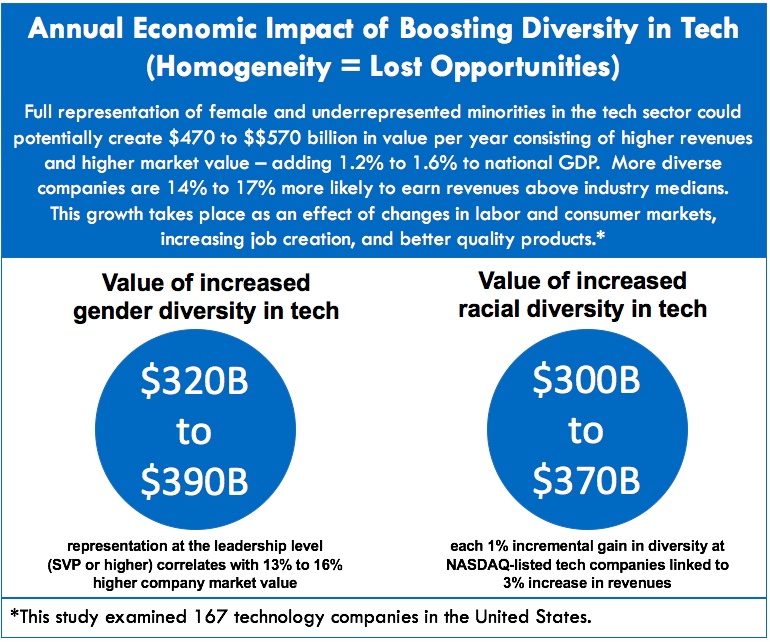
Source: Intel (2016)
This study highlights the loss many companies face by not embracing a comprehensive strategy to reflect diversity and inclusion in their work environment. Having disproportionately white and Asian male employees is a multi-billion dollar missed opportunity in Silicon Valley.
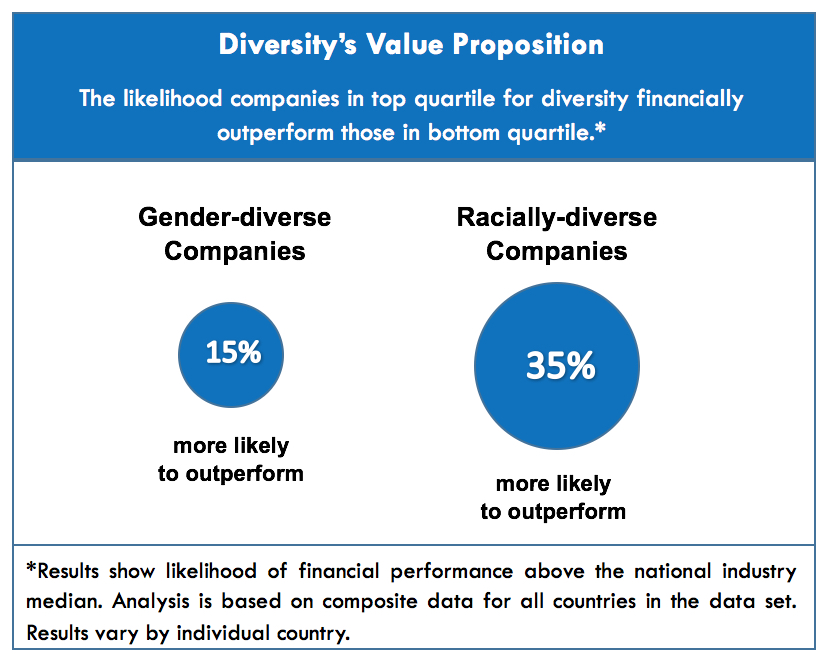
Source: McKinsey & Company (2015)
A 2015 McKinsey & Company report showed an additional side of the story. It found that gender-diverse and racially-diverse companies are more likely to outperform less diverse competitors. Racially-diverse companies are 35% more likely to perform better and gender-diverse companies are 15% more likely to perform better than their less diverse counterparts. Improved employee performance and profits come hand in hand with effective strategies and comprehensive plans to reflect diversity in the company.
2. Diversity = Increased Shareholder Value
The financial return on diversity is also captured in a 2012 research study by McKinsey & Company – showing companies with diverse leadership return greater value. American companies with diverse executive boards that fell into the top quartile of companies studied had a 95% higher return on equity than those in the lowest quartile. The study also revealed that earnings before interest and taxes (EBIT) margins at the most diverse U.S. companies were 58% higher, on average, than those of the least diverse companies.
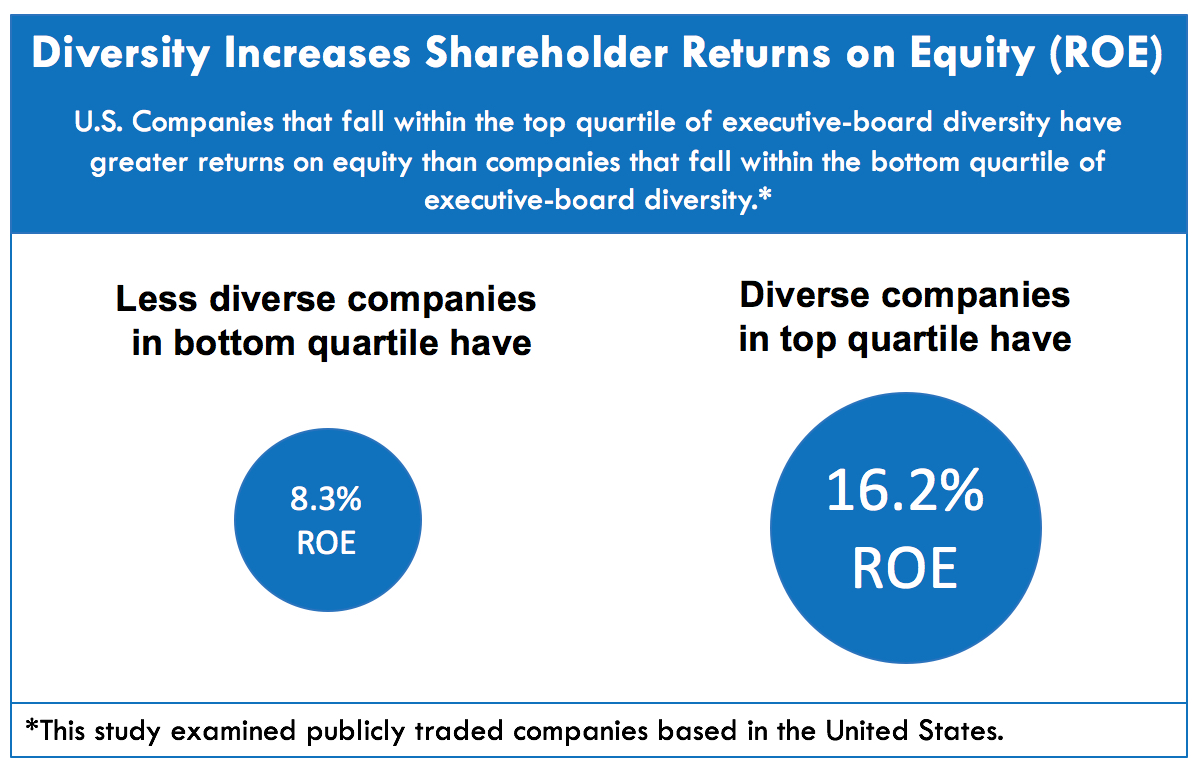
Source: McKinsey & Company (2012)
Having a diverse leadership team is just as important as having diverse employees, if not more. They represent the company in various capacities as key decision makers who can set the tone internally and externally for the company. These stakeholders have the ability to move the company forward by implementing and promoting inclusive work cultures and practices. As board members they can drive change, but most importantly they bring an inclusive lens to the table in making business decisions that steer the company and its profitability.
3. Diverse Workplaces = Attracting Diverse Talent
A company is only as great as its workforce and ability to attract and retain top talent. To remain competitive in Silicon Valley, being an employer of choice is critical. However, since the tech industry has traditionally positioned itself as being less welcoming to women and people of color, the sector is missing out on the best talent. The lack of industry diversity promotes talent flight.
Naturally, people like to go where they feel welcome and see others who look like them. When they feel unwelcome, they often elect to pursue careers elsewhere – in other more inclusive industries, companies, and geographic regions. This talent flight translates into lost opportunities, fewer innovations, and less profitable business outcomes as evidenced by the upwards of $570 billion left on the table according to the Intel study.
The tech sector needs to refine and innovate constantly to stay on top, and thus recruiting the best employees is a big part of the process. When there is proportionate representation of employees from diverse backgrounds, people will be more likely to stay and draw in others with fresh ideas. It becomes a positive multiplying force in shaping a company’s culture, image, and workforce.
4. Homogeneity = Missed Opportunities! Myopic Teams Create Myopic Products & Solutions
Having diverse teams and inclusive perspectives on product teams not only sparks creativity and innovation, but also limits embarrassing missteps when companies produce and market products in culturally-insensitive ways.
Google is an example of a company whose homogeneity resulted in a public blunder – where having more than 2% black employees may have saved them from public outrage. In 2015, they came under fire when their photo sharing and storage service, Google Photos, started tagging black people in one of the most racist ways possible – as gorillas. This raised questions about the team of employees who oversaw this project. Their inability to prevent this software outcome by designing a better product before launching raised eyebrows – especially since this was on the heels of Flickr having done the same thing several months prior by labeling blacks as “apes” in photos. In the end, Google’s Chief Architect of Social issued a public apology after deeply offending many people.
However, what is more impactful to a company’s bottom line may not be the collateral damage resulting from shameful gaffes that drive away customers and cause lost market share. It is the missed opportunities from having a myopic approach to business where outcomes are less inclusive of the country’s multicultural landscape due to having homogenous teams and business units.
A prime example comes from the global remittance industry. Remittances are money transfers made by foreign workers back to someone in their home country – often only a few hundred dollars at a time. Between 2000 and 2012, the market has tripled and money transfer fees have decreased significantly. In 2014, remittances to developing countries totaled $436 billion out of $583 billion worldwide. In 2015, the World Bank valued the global remittance industry at $646 billion, and the market is expected to crack one trillion-dollars in the coming years. Banks handle the majority of remittances, with companies like Western Union dominating the non-bank market.
With so many immigrants sending money back home on a regular basis, “mainstream” tech companies are starting to notice this business opportunity. However, no major tech players entered this market early.
One financial tech startup that did notice earlier than companies like PayPal is Regalii, which has been gaining traction and tapping into this market. Its founders are Latino, have personal experience with remittances, and can communicate to targeted immigrant groups to better assess their needs. Regalii is based in New York City, began operating in 2013, and has gotten funding from FinTech investors like Andreessen Horowitz, Kapor Capital, and Y Combinator. As of 2017, their platform powers over 30 remittance companies, banks, and mobile wallets across 11 countries.
A sign that more established tech players now want to enter the lucrative remittance market is PayPal’s 2015 acquisition of money-transfer firm Xoom for $890 million. PayPal’s leadership and tech employees are 3% Latino and 2% black. Arguably, if Silicon Valley were more racially-diverse, it may have moved into this market sooner – capitalizing on the value in the growing remittance market and snatching up more dollars earlier to bolster profit share.
This indicates diversity has significant monetary value. Investing and supporting diversity is not just about doing “what is right,” and it is not about having people sing Kumbaya to celebrate Kwanzaa. Diversity makes sense since it generates dollars and cents.
Google’s gorilla and the remittance industry examples are not outliers. They reaffirm the need for more diverse teams at tech companies. They amplify the call by consumers and employers for tech companies to truly diversify, stop “paying lip service,” and come up with viable solutions to expand inclusivity with tangible results. Otherwise, the lack of heterogeneity among tech’s workforce will continue to generate obstacles impeding the creation of new products and innovative services that are highly profitable, widely accessible, and respectful and inclusive of diverse customer groups.
Same Old Trite Song – No “Disruptors” in How Tech Approaches Diversity
Tech companies are constantly creating headlines for the large sums of money they have directed at diversity and inclusion efforts – often touting their new partnerships with non-profits that support STEM education for underrepresented groups. While they should be recognized for these efforts, they are not doing anything innovative or creative in an industry that prides itself on being “disruptors.”
They just seem to be going through the motions, responding to peer pressure, doing what their neighbors are doing, and implementing the bare minimum. They throw some money at the problem in less strategic ways, hire a few diversity leaders, support non-profits, and establish affinity groups. Where have these baby steps gotten them? Not far.
For a tech giant like Google, its recently-updated employee demographic data proves this point. Little has changed over the past few years. It shows women make up only 31% of the company’s workforce overall. In addition, white and Asian employees make up over 90% of employees. In 2015, these numbers were 30% and over 90%, respectively. What these companies are doing to advance diversity is yielding marginal results at best.
Here is a snapshot of what some of the biggest names in tech have in place to address diversity.
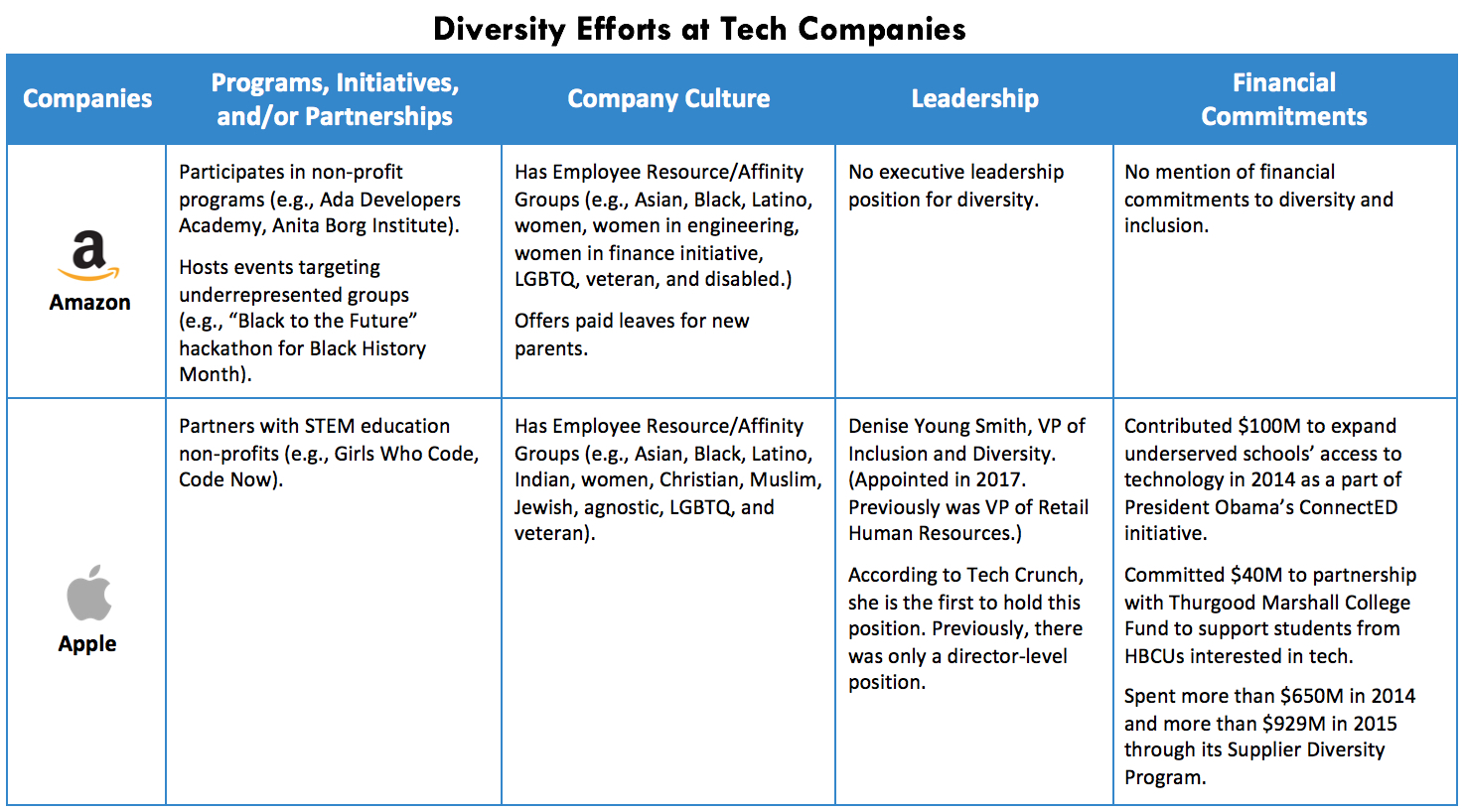
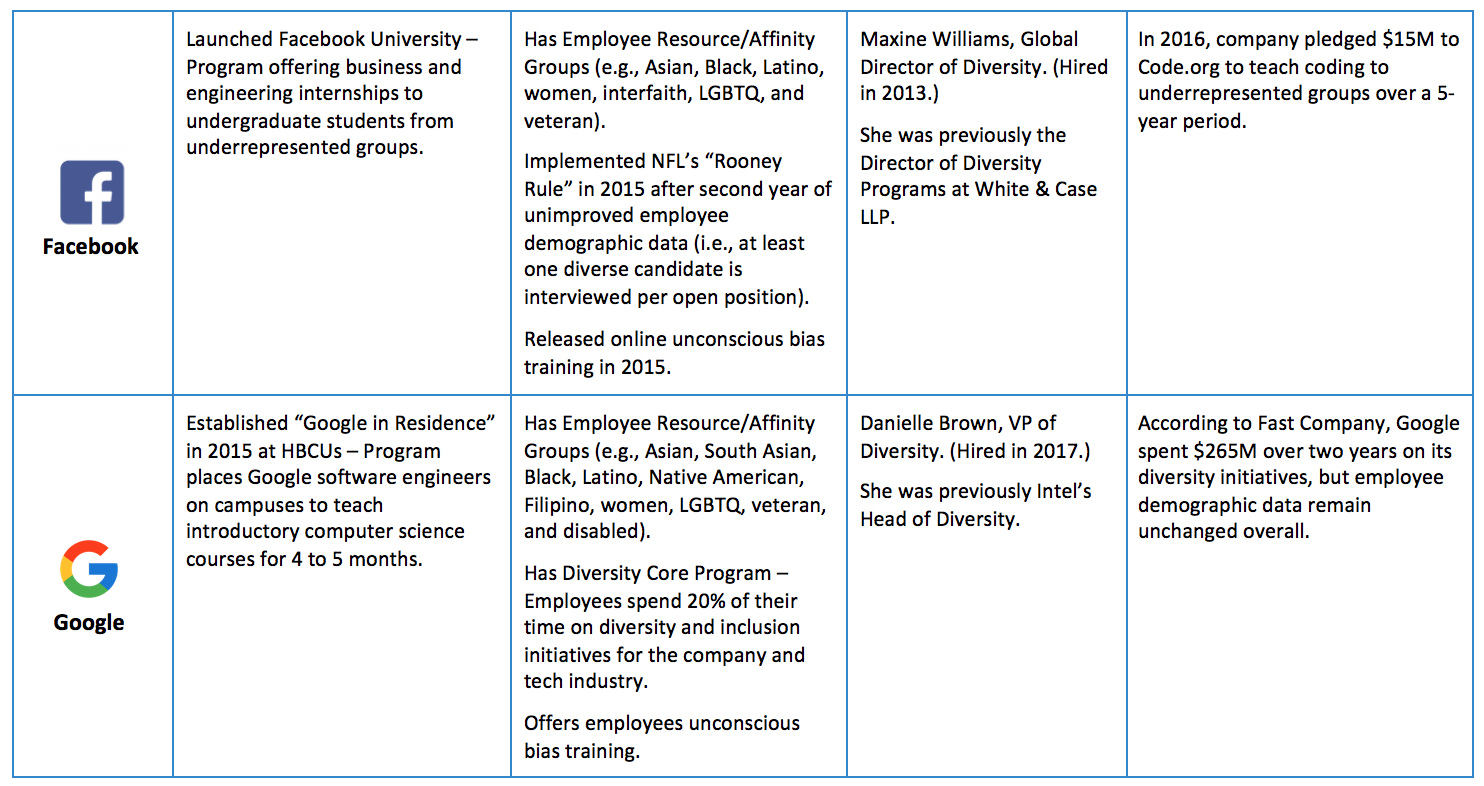
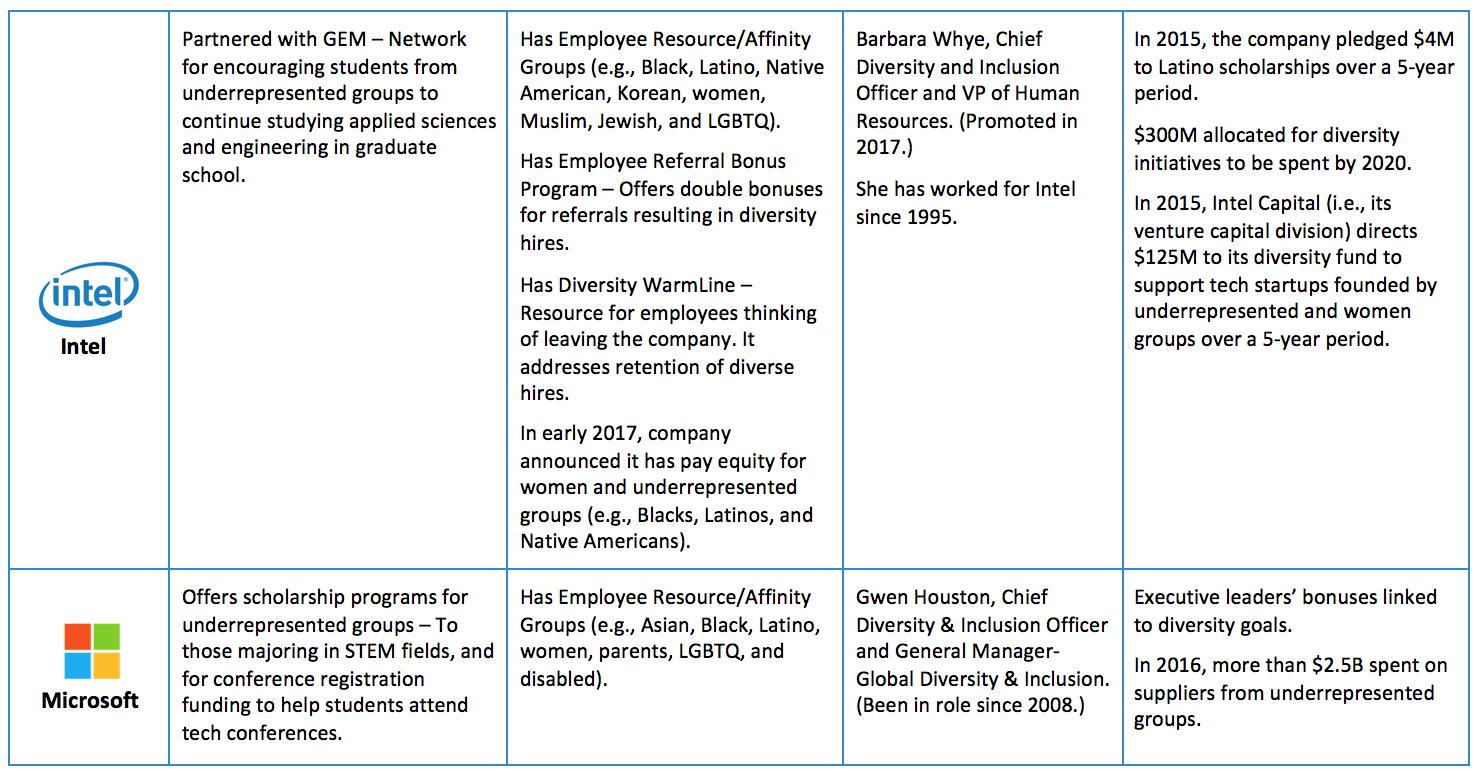

Source: Amazon, Apple, Apple, Black Enterprise (2017), Business Insider (2016), Facebook, Fast Company (2017) Google, Intel, Microsoft, Microsoft, Tech Crunch (2017), Tech Crunch (2017), The Verge (2017), The Verge (2017), Twitter, USA Today (2017), USA Today (2017), USA Today (2017), VentureBeat (2015)
As the chart above shows, tech companies taking steps in the right direction, but they do not go far enough. There are no clear leaders, innovators, or disruptors. Fostering diversity is not a one-step process and needs to go beyond the expected and typical.
As a whole, the industry relies on excuses to explain why companies cannot make progress or overcome challenges. Often, they are quick to point to the “talent pipeline” problem for their unimproved employee demographics. It is a cheap cop out that seeks to get them off the hook from truly looking under the hood.
According to U.S. census data, while Silicon Valley has roughly 2.2% blacks and 4.7% Latinos, cities like New York have 7.3% blacks and 9.6% Latinos in tech, and 20.6% of Atlanta’s tech employees are black while 29.9% of Miami’s tech workers are Latino. If other regions can draw minorities into tech, then Silicon Valley can too.
Claiming this talent pipeline excuse leads to oversimplified “solutions” – that tackling diversity and inclusion is just about giving money to programs and universities for underserved groups. Although these are notable steps, they do not recognize or address the full scope of the issue. There are diverse people in STEM, but they just do not flock specifically to Silicon Valley.
However, mindsets need to adjust beyond talent pipeline claims. General perceptions about whether there is an issue in the first place and what is the cause of the lack of diversity in Silicon Valley also need to shift. A 2017 survey by Atlassian showed that although tech’s diversity data are not getting better overall, roughly only 50% of tech employees think there needs to be improvement. It is time to face reality and evaluate whether companies are merely putting on a good show for press releases or actually trying to implement real change.
Not only do these companies need to improve their numbers, but they need to move their employees’ mindset. It is exactly this kind of thinking that led to the August 2017 incident at Google where an employee released a 10-page memo claiming that the lack of gender diversity in tech was due to biological inadequacies in women. This resulted in a firestorm of backlash, the employee being fired, and calls for the CEO to resign.
Why Repeat Broken Approaches?
Why has there been so little progress in Silicon Valley in spite of implementing various initiatives? It is because companies replicate broken approaches and have superficial solutions. Tech companies need to step up their game. Why recycle the same ineffective approaches and reuse the same diversity officers from one company to the next when the results are weak at best?
For example, if Intel is not hitting it out of the park with diversity and has barely moved its numbers, why should Google repurpose the same person? If your diversity numbers have been dismal for a decade, why not make some leadership and talent changes? For an industry that prides itself on innovation and being forward thinking, when it comes to diversity, they operate like they are living in the past.
There is a clear business case for diversity – we already laid out the financial impacts of more inclusive workplaces and corporate boards. With such a weighty payoff, the time has come for significant shifts in how companies approach diversity solutions. The key is to analyze and plan comprehensively, and be more strategic in targeting internal process in hiring, retaining, and promoting diverse talent. Companies need to recognize diversity as a way of doing business – integral to all that it does and not as some side project.
Three-Part Solution – Treat Diversity with the Same Importance as Product Launches:
From Google to Apple, many of the sector’s products and services have become so integrated into our lives. It is hard to imagine a life without them or even an alternative. Tech companies have been very successful in creating and promoting products that are changing the way people live and society operates. They revolutionized how we engage with each other and communicate globally. Now it is time for them to disrupt their own internal business practices so they can truly be 21st century companies.
Tech companies need to apply the same level of problem solving and dedication to advancing workplace inclusion in Silicon Valley as they do in launching a new phone or operating system update. If equal levels of prioritization, leadership support and involvement, and human and financial resources were directed towards diversity and inclusion efforts, Silicon Valley companies would be enjoying another boost to their bottom line.
When crafting a plan for your company, ask the following three questions to determine whether your strategy is effective. The goal is to transition your approach from a pet project to a business solution. The key to success is treating diversity as a business imperative and part of your overall business model.
1. Who’s on Your Team?
Designating diversity leaders and officers is a step in the right direction, but business problems are not easily solved with just the efforts of one or two people. The next critical step is to form cohesive teams and taskforces to oversee and support the different parts of developing a strategy. From there, the strategy needs to be implemented in a way that permeates all corners of the company, and then the organization needs to monitor for accountability.
Hire experienced and knowledgeable talent from varied backgrounds who are invested in helping the company meet diversity and inclusion goals. Collaboration and sharing responsibility across a broad team is important when solving any business problem. It will get everyone on the same page and help draw out new ideas. However, companies need to disrupt the status quo in spearheading those solutions and forming teams.
Think outside the box and bring in people who are not just professionals in human resources. Also, hire people with a strategic eye for business and innovation. Include business leaders, yet simultaneously make sure those managing this process do not have other “day jobs” so diversity does not become an extracurricular distraction with minimal impact. When the key players driving diversity or overseeing employee affinity groups still have businesses to run as their primary focus, then their real perceived value add for the company is measured elsewhere. Thus, diversity falls through the cracks and is relegated to being an ad hoc endeavor.
2. How Deep Is Your Wallet?
You cannot reap the full financial benefits of diversity with chicken-feed budgets. Money talks in business. This is no different for diversity and inclusion.
Moving the needle requires adequate financial resources. Many Silicon Valley companies do not allocate sufficient funding for things like employee resource groups, bringing in outside consultants, and building robust diversity leadership teams. Thus, too many diversity teams and initiatives lack the money to do anything substantive – leaving people scrounging and begging for dollars for the simplest efforts. While it may be flashy to announce giving $50 million to new external diversity partners, companies should not forget to invest internally too. In fact, internal initiatives may be where they should direct the bulk of their funding.
Designate a substantial sum that shows the company is making a serious commitment – just as it would to ensure a new product is ready for consumers. This budget should account for strategizing and implementing a comprehensive plan. The financial backing should not be a one-time allocation, but tied to each step of the process and a long-term vision for change throughout the company.
3. What’s Your Infrastructure? Where’s the Post-Strategy Launch Follow Up, Clear Metrics, Accountability & Troubleshooting?
After strategies are developed and initiatives implemented – then what? Once a company has launched various policies and partnerships, they struggle to see desired results. Why?
The missing piece could be that they have not created enough infrastructure. Their diversity strategy and platform could be (1) lacking adequate follow up and monitoring, (2) failing to develop metrics to measure results and understand the strategy’s impact, (3) not evaluating the relative benefits of one approach compared to another to know what are the best practices for their specific organization, and (4) dropping the ball in holding leaders and managers accountable throughout the company so everyone is responsible for diversity.
Once a strategy is put in place, it will need refinement, troubleshooting, and occasional redesign. Diversity work is continual and not stagnant – just like how the first smart phone now seems prehistoric since it has been updated and evolved. In order to get past a perpetual “beta phase” for diversity, companies must continually improve existing strategies and initiatives.
Final Thoughts
Prioritizing diversity and inclusion is not just a preventive measure against a toxic company culture and response to public backlash. Most importantly, diverse workplaces are the key to business growth for tech companies. Moving forward, there is no benefit in keeping your company dominated by homogeniuses (i.e., highly intelligent people who look alike and have similar backgrounds). These environments increase your risk of going down the same embarrassing path as Uber and other tech companies plagued by scandal.
Silicon Valley has tapped into its vast potential and introduced countless innovations that have transformed the way we live and work. Tech companies have the chance to do this again by making the companies themselves the focus. By truly taking on diversity and inclusion, the tech industry will not only propel itself forward financially, but also stand at the forefront of another tech revolution.
In order to avoid lost opportunities and leaving money on the table with homogenius workplaces, companies need to always have an eye on evolving, continually disrupting, and forever adapting diversity strategies. To get there, they must build a model and create an internal infrastructure that supports a diversity platform that is progressive. When this happens, Silicon Valley will truly become companies of and for the future.
The Azara Group is experienced in helping companies evaluate, strategize, and implement effective diversity and inclusion initiatives that bring change to the face of companies while positively impacting an organization’s bottom line. We are here to help you be an industry leader and embrace the positive benefits of diversity as 21st century companies.
Our Additional Diversity in Tech Articles
For our advice on homogeniuses in the tech industry, check out the first article in this series.
For our advice on avoiding and bouncing back from scandals tied to weak diversity efforts, check out the second article in this series.
The Azara Group (TAG) is a consulting firm that promotes the development of leaders in an increasingly competitive and diverse marketplace – providing strategy consulting services and leadership training services to advance professional and life success. TAG leverages expertise in career strategy, diversity, negotiation skills, and business acumen to provide strategic advice and consulting services to help people and organizations get what they want, achieve their goals, and advance their business and career objectives. TAG also helps companies better attract, retain, and promote diverse talent, and develop robust diversity platforms and strategies to create a more inclusive workplace.
The Azara Group welcomes your direct comments and feedback. We do not post comments to our site at this time, but we value hearing from our readers. We invite you to share your thoughts with us. You can contact us directly at info@theazaragroup.com.
 The Azara Group
The Azara Group